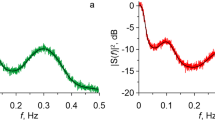Abstract
Atrial fibrillation (AF) is characterized by desynchronization of atrial electrical activity causing a consequent irregular ventricular response. In AF, the beat-to-beat variation of blood pressure is increased because of variations in filling time and contractility. However, only a few studies have analyzed short-term blood pressure variations in AF, and we have recently observed a harmonic low-frequency (LF) component in systolic arterial pressure (SAP) during AF. Aim of the present study is to propose a method to verify the reliability of the spectral component found in SAP series, based on the position of the poles of the autoregressive spectral decomposition in the z-plane. In particular, 1,000 random permutations of the series allowed the definition of an area in the z-plane where poles from random process are likely to occur. Poles lying outside this area are considered as reliable oscillations. We tested the method on 53 recordings obtained at rest from patients with persistent AF. LF component was found in, respectively, 51 and 43 recordings in SAP and RR series. High-frequency (HF) component was found in all the recordings for both SAP and RR series. Using the proposed test, the percentage of reliable components in LF and HF bands was 80 and 38 in SAP series, and 20 and 18 in RR series. We concluded that, at variance with RR ones, SAP LF components are likely to represent true physiological oscillations.







Similar content being viewed by others
References
Akaike H (1970) Statistical predictor identification. Ann Inst Statist Math 22:203–217
Avolio A, Westerhof BE, Siebes M, Tyberg JV (2009) Arterial hemodynamics and wave analysis in the frequency and time domains: an evaluation of the paradigms. Med Biol Eng Comput 47:107–110
Baselli G, Cerutti S, Civardi S, Lombardi F, Malliani A, Merri M, Pagani M, Rizzo G (1987) Heart rate variability signal processing: a quantitative approach as an aid to diagnosis in cardiovascular pathologies. Int J Biomed Comput 20:51–70
Chandler S, Trewby P (1994) Is respiratory sinus arrhythmia present in atrial fibrillation? A study using two quantitative methods. Med Eng Phys 16:334–337
Corino VDA, Belletti S, Terranova P, Lombardi F, Mainardi LT (2009) Linguistic analysis of heart rate and systolic blood pressure in patients with persistent atrial fibrillation. In: Proceddings of the BSI, pp 17–20
Fuster V, Rydén LE, Cannom DS, Crijns HJ, Curtis AB, et al (2006) ACC/AHA/ESC 2006 guidelines for the management of patients with atrial fibrillation: a report of the American College of Cardiology/American Heart Association Task Force on practice guidelines and the European Society of Cardiology Committee for Practice Guidelines developed in collaboration with the European Heart Rhythm Association and the Heart Rhythm Society. Europace 8:651–745
Kay SM, Marple SL (1981) Spectrum analysis: a modern perspective. IEEE Trans Biomed Eng 69:1380–1419
Khoo MCK (1999) Physiological control system: analysis, simulation, and estimation. Wiley-IEEE Press, New york
Mainardi L (2009) On the quantification of heart rate variability spectral parameters using time-frequency and time-varying methods. Philos Trans Royal Soc A 367:255–275
Mainardi LT, Corino VDA, Belletti S, Terranova P, Lombardi F (2009) Low frequency component in systolic arterial pressure variability in patients with persistent atrial fibrillation. Auton Neurosci 51:147–153
Mitchell GF (2009) Clinical achievements of impedance analysis. Med Biol Eng Comput 47:153–163
Oppenheim AV, Schafer RW (1975) Digital signal processing. Prentice-Hall, Englewood Cliffs
Pagani M, Lombardi F, Guzzetti S, Rimoldi O, Furlan R, Pizzinelli P, Sandrone G, Malfatto G, Dell’Orto S, Piccalunga E, Turiel M, Baselli G, Cerutti S, Malliani A (1986) Power spectral analysis of heart rate and arterial pressure variabilities as a marker of sympatho-vagal interaction in man and concious dog. Circ Res 59:178–193
Pitzalis M, Forleo FMC, Fioretti A, Colombo R, Balducci C, Mastropasqua F, Rizzon P (1999) Respiratory systolic pressure variability during atrial fibrillation and sinus rhythm. Hypertension 34:1060–1065
Rawles JM, Pai GR, Reid SR (1989) Paradoxical effect of respiration on ventricular rate in atrial fibrillation. Clin Sci (Lond) Sci 76:109–112
Stein KM, Walden J, Lippman N, Lerman BB (1999) Ventricular response in atrial fibrillation: random or deterministic? Am J Physiol 277:H452–458
Task Force of The European Society of Cardiology and The North Americam Society for Pacing and Electrophysiology (1996) Heart rate variability: Standards of measurement, physiological interpretation, and clinical use. Circulation 93:1043–1065
Van den Berg MP, Haaksma J, Brouwer J, Tieleman RG, Mulder G, Crijns HJ (1997) Heart rate variability in patients with atrial fibrillation is related to vagal tone. Circulation 19(96):1209–1216
Yang ACC, Hseu SS, Yien HW, Goldberger AL, Peng CK (2003) Linguistic analysis of the human heartbeat using frequency and rank order statistics. Phys Rev Lett 90(10):108,103
Zetterberg LH (1969) Estimation of parameters for a linear difference equation with application to EEG analysis. Math Biosci 5:227–275
Author information
Authors and Affiliations
Corresponding author
Rights and permissions
About this article
Cite this article
Corino, V.D.A., Lombardi, F. & Mainardi, L.T. On the reliability of frequency components in systolic arterial pressure in patients with atrial fibrillation. Med Biol Eng Comput 48, 381–387 (2010). https://doi.org/10.1007/s11517-010-0588-z
Received:
Accepted:
Published:
Issue Date:
DOI: https://doi.org/10.1007/s11517-010-0588-z




